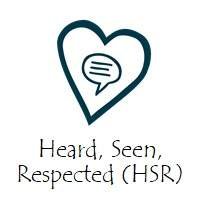
Heard, Seen, Respected is a liberating structure to practice deep listening and empathy
With Heard, Seen, Respected (HSR) you can foster the empathic capacity of participants to “walk in the shoes” of others.
This activity helps individuals learn to respond in ways that do not overpromise or overcontrol. It helps members of a group notice unwanted patterns and work together on shifting to more productive interactions.
Many situations do not have immediate answers or clear resolutions. Recognizing these situations and responding with empathy can improve the “cultural climate” and build trust among group members.
Participants experience the practice of more compassion and the benefits it engenders.
Four Structural Elements
1. Structuring Invitation
- Invite participants to tell a story to a partner about a time when they felt that they were not heard, seen, or respected.
- Ask the listeners to avoid any interruptions other than asking questions like “What else?” or “What happened next?”
2. How Space Is Arranged and Materials Needed
- Chairs facing each other, a few inches between knees
- No tables
3. How Participation Is Distributed
- Everyone has an equal amount of time, in turn, to participate in each role, as a storyteller and a listener
4. Sequence of Steps and Time Allocation
- Introduce the purpose of HSR: to practice listening without trying to fix anything or make any judgments. 3 min.
- One at a time, each person has 7 minutes to share a story about NOT being heard, seen, or respected. 15 min.
- Partners share with one another the experiences of listening and storytelling: “What did it feel like to tell my story; what did it feel like to listen to your story?” 5 min.
- In a foursome, participants share reflections using 1-2-4, asking, “What patterns are revealed in the stories? What importance do you assign to the pattern?” 5 min.
- As a whole group, participants reflect on the questions, “How could HSR be used to address challenges revealed by the patterns? What other Liberating Structures could be used?” 5 min.
Purposes and Objectives
- Practice deeper listening and empathy with colleagues
- Reveal how common it is for people to experience not being heard, seen, or respected
- Reveal how common it is for people to behave in a way that makes other people feel they are not being heard, seen, or respected
- Improve listening, tuning, and empathy among group members
- Notice how much can be accomplished simply by listening
- Rely on each other more when facing confusing or new situations
- Help managers discern when listening is more effective than trying to solve a problem
Tips
- Say, “Your partner may be ready before you. The first story that pops into mind is often the best.”
- Make it safe by saying, “You may not want to pick the most painful story that comes to mind.”
- Make it safe by saying, “Protect carefully the privacy of the storyteller. Ask what parts, if any, you can share with others.”
- Suggest, “When you are the listener, notice when you form a judgment (about what is right or wrong) or when you get an idea about how you can help, then let it go.”
Examples
- For regular meetings to improve the quality of listening and tuning in to each other
- For transition periods when questions about the future are unanswerable (e.g., post-merger integration, market disruptions, social upheaval) and empathetic listening is what is needed
- When individuals or groups have suffered a loss and need a forum to share their grief or despair


